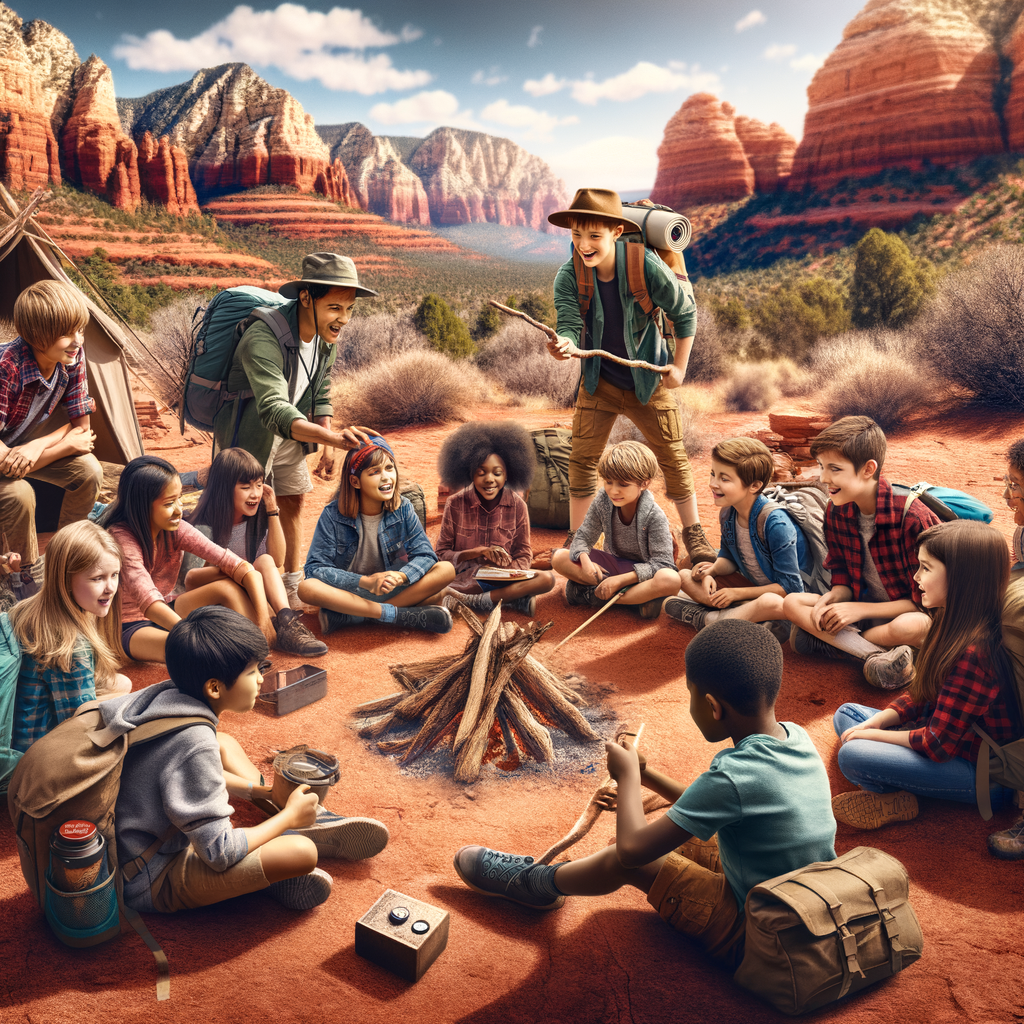Teaching Kids Essential Survival Skills for Outdoor Adventures
“`html
Learn Survival Skills: Teaching Kids Essential Techniques
Introduction to Survival Skills for Kids
In today’s fast-paced digital world, many children are missing out on vital skills that can help them navigate the great outdoors. Teaching kids basic survival skills not only prepares them for unexpected situations but also instills a sense of confidence and independence. Imagine taking your child on a camping trip where they can truly connect with nature and learn to thrive when the going gets tough! Wouldn’t that be a fulfilling experience? In this article, we’ll dive into essential survival skills like fire-building and shelter-making, making it fun and engaging for both you and your kids.
Before we get into the nitty-gritty of the skills, let’s highlight the importance of teaching these techniques. Survival skills can empower children, giving them the tools to face real-world challenges. In an age where kids can easily lose themselves in screens, these hands-on experiences can foster a sense of adventure and curiosity. If you’re ready to create memorable outdoor adventures while equipping your kids with life-saving skills, keep reading!
Why Teach Survival Skills?
Some might wonder why it’s critical to teach kids survival skills when they have access to technology and modern conveniences. Well, life can be unpredictable! Nature can present challenges that require quick thinking and resourcefulness. When kids learn how to build a shelter or create a fire, they’re not just picking up random skills—they’re learning to solve problems creatively. Plus, these experiences can lead to exciting family bonding moments, transforming ordinary outings into extraordinary adventures.
Fire-Building Basics
Who doesn’t love a crackling campfire? Teaching your kids the art of fire-building can be both fun and educational. The first step is to gather materials—tinder, kindling, and logs—while explaining the roles each plays in sustaining a fire. You can use natural items like dry leaves, grass, and small twigs for tinder, while sticks and larger pieces of wood serve as kindling and fuel. Engage your kids by making a game out of collecting these materials! As they learn, they’ll also appreciate the work that goes into starting and maintaining a fire.
Once you’ve collected everything, demonstrate how to arrange the materials in a fire pit, ideally in a teepee or log cabin style. Safety is crucial here, so make sure to instill the importance of being cautious and keeping a safe distance. Allow your child to light the fire with a striker or a match, closely supervised, of course! Watching that first spark ignite can be incredibly thrilling for them. Remember to explain how to put out the fire responsibly afterward—teaching them the importance of leaving no trace in nature.
Advanced Fire Techniques
After mastering the basics of fire-building, consider introducing your kids to advanced techniques, like using a fire starter or creating a friction fire using a bow drill. These methods require patience and practice, so be prepared for some trial and error. Encourage your kids not to get discouraged; every failure is an opportunity to learn! Support their persistence by celebrating small victories, whether it’s successfully gathering materials or creating sparks. This journey can teach them resilience and grit, skills that apply beyond the campfire.
As they explore these advanced techniques, you can weave in lessons about survival situations where fire is critical—staying warm, cooking food, and signaling for help. Making the lessons applicable to real-life scenarios will make them more relatable. Why not turn fire-building into a fun challenge? Set a timer and see if your kids can build a fire in under a specific time. This playful element will keep them engaged and excited about learning something new!
Building a Shelter: Its Importance
In survival situations, having proper shelter is paramount, protecting individuals from the elements and providing a sense of security. Teaching kids how to build a shelter can help them understand the significance of planning and constructing a safe space in the wild. Start with the basics by explaining different types of shelters: natural ones made from available materials and man-made options equipped with tarps or blankets. Engage your kids in a friendly discussion about which ones might work best for different terrains and weather conditions.
Take a hands-on approach by having your kids collect materials like branches, leaves, and grass. When building a shelter, demonstrate how to create a frame and cover it with ample insulation for warmth. Encourage your children to put their creativity to work! For instance, let them decide the layout—this will give them ownership of the project and reinforce problem-solving skills. Before you know it, they will be imagining their very own cozy nook in the wilderness!
Types of Shelters
There are numerous types of shelters kids can learn to build, such as debris huts, lean-tos, and tarps. The debris hut is an exciting challenge, allowing children to use natural materials to create a snug, warm environment. Discuss what makes a good location: away from wind and above potential flooding. When they understand the rationale behind the structure, it solidifies their knowledge. Plus, nothing beats the satisfaction of seeing their efforts come to life!
Another fantastic approach is to teach them about the versatility of tarps. Show them how to rig up a tarp for quick and efficient shelter, which comes in handy during unexpected rainstorms. This practical skill encourages adaptability and teaches that there’s often more than one solution to a problem. With enough practice, your kids will become adept at creating a variety of shelters, ushering in a newfound respect for the outdoors and survival skills!
Connecting with Nature through Survival Skills
When children learn survival skills, they aren’t just picking up practical knowledge; they’re creating lasting memories and establishing a connection with nature. This hands-on experience cultivates patience and fosters creativity—after all, who wouldn’t feel accomplished after building a sturdy shelter or starting their first fire? Through survival training, children learn to appreciate the beauty of their environment and the importance of preserving it. What better way to lull them away from screens and into the natural world?
Moreover, creating a nurturing atmosphere where learning is fun is the key. Involve games, challenges, and storytelling into your sessions. For instance, create a narrative about stranded adventurers needing to build shelter and gather resources—this narrative approach makes skills unforgettable. By framing their lessons in this engaging context, you’re not just teaching; you’re igniting their zest for exploration, curiosity, and outdoor adventure!
Safety First: Responsible Outdoor Ethics
While embracing survival skills, instilling a strong sense of responsibility toward nature and safety must be paramount. Before you even think about heading out, lay down ground rules. Talk about the dangers, such as allergic plants, animals, and natural hazards. Ensuring your kids understand that nature should be respected will help them become conscientious explorers. Guarding against wildfires when building a fire and only using established campgrounds can reinforce these ethical lessons.
In addition to safety, teach children the “Leave No Trace” principles. They should learn to clean up after themselves and recognize the importance of wildlife preservation. Engage in discussions about how littering and harming natural habitats can have lasting detrimental effects. By promoting responsible behavior in tandem with skill-building, you’re nurturing not just capable individuals but also future stewards of the Earth.
Conclusion
In essence, equipping your kids with basic survival skills is not only about teaching them how to survive in the wild—it’s about weaving a tapestry of resilience, responsibility, and respect for nature. Through activities like fire-building and shelter-making, you’re giving them the tools to thrive, both outdoors and in life. So, gather your family, head into the great outdoors, and embark on an adventure of knowledge and connection that will last a lifetime. Together, you can make cherished memories while bonding over essential life skills that your kids will carry into adulthood!
FAQs
1. What age is suitable for teaching survival skills to kids?
There’s no hard and fast rule, but children as young as six can grasp basic concepts like fire safety or shelter-building with guidance. It’s crucial to adapt the lessons to their developmental levels, ensuring they remain engaged and safe throughout the process.
2. How can I make survival skills fun for my kids?
Incorporate games, storytelling, and challenges! Create adventure stories where your kids are the heroes and need to use their survival skills. Turning the lessons into a narrative helps cement their knowledge while keeping their excitement high.
3. Are there specific items I need for teaching survival skills?
Basic outdoor gear like a tarp, rope, and matches are helpful. Always prioritize safety equipment like first-aid kits and encourage kids to use natural materials when possible. These items will help make your lessons practical and engaging.
4. Where can we practice these survival skills safely?
Local parks, camping grounds, or nature reserves are great places to practice. Ensure you choose spots close to home, where facilities are available for emergencies, and always check local regulations about outdoor activities.
5. How do I ensure my children’s safety while teaching them survival skills?
Always supervise activities closely and instill a strong emphasis on safety rules. Start with lessons in controlled environments and gradually progress to more challenging settings while maintaining safety measures. Teaching the importance of caution can help ingrain responsible outdoor habits.
If you are interested in looking into an organized tour for you and your kids, consider visiting our preferred vendor: Sedona Red Rock Adventures.
“`
news via inbox
To be update with all the latest news.




